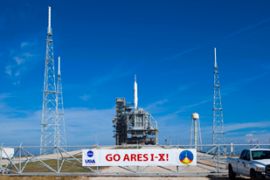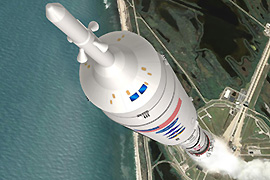Nasa new-era rocket launch delayed
Poor weather prevents test of first step towards returning people to the moon.

The test is planned to last for two minutes with the $45m rocket not leaving the Earth’s atmosphere.
The main body of the rocket will drop to Earth, into the Atlantic Ocean, for retrieval.
The head of the rocket – all fake parts – will fall uncontrolled into the ocean.
Constellation generation
Nasa officials hope the flight will provide valuable data on the rocket’s performance, despite deep uncertainty over the space programme’s future.
| Ares I-X rocket |
|
|
The 100m-high rocket is a key part of Nasa’s planned next generation of manned vehicles – dubbed Constellation – which the agency hopes will replace the ageing space shuttle fleet due to be retired next year.
It hopes to use an Ares rocket to launch the first astronauts into orbit in 2015, beginning a new chapter of manned space flight that it says will take humans back to the Moon and onwards to a landing on Mars.
A much larger rocket, the Ares V, would be used to blast the necessary hardware into space which would then rendez vous with the manned capsule before the assembled spacecraft begins its mission.
But an independent panel of experts last week threw cold water on Nasa’s ambitions in a report to the White House, warning that the agency needs $3bn a year in extra funding to meet its goals.
In the 155-page report released on Thursday, panel leader Norman
Augustine, former president of aerospace company Lockheed Martin, said a lack of funding meant Nasa’s human space flight programme “appears to be on an unsustainable trajectory”.
Instead the report from the 10-member-panel proposed the idea of manned space flights to asteroids, as well as flyovers close to the Moon and Mars, both of which would avoid the need to factor in complicated landing arrangements.

 Rocket is 99.6m high, 10m taller than the Statue of Liberty
Rocket is 99.6m high, 10m taller than the Statue of Liberty